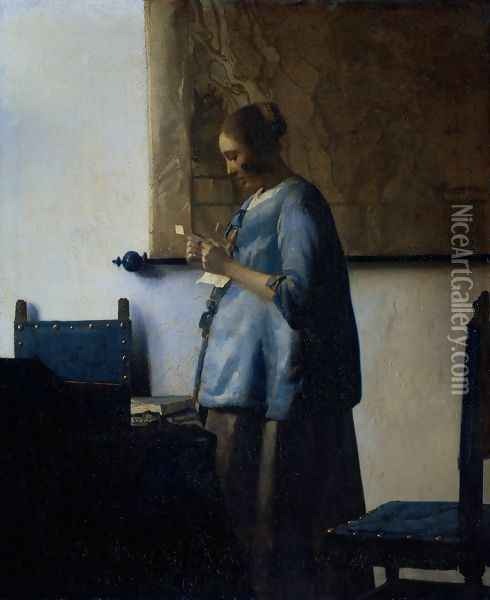Introduction
Johannes Vermeer’s “Woman Reading a Letter” is a luminous example of his exceptional ability to capture the interplay of light and shadow. This painting, a jewel in the crown of Vermeer’s oeuvre, encapsulates the quiet drama and introspective mood that characterize his work. This article delves into the subtleties of “Woman Reading a Letter,” exploring how Vermeer’s mastery of light and composition creates a narrative that extends beyond the canvas.
Renowned for his profound treatment of domestic scenes, Vermeer transforms a simple moment into a scene brimming with emotion and narrative depth. “Woman Reading a Letter” is not just a depiction of a woman engaged in reading; it is a visual exploration of the power of light to reveal and conceal, both literally and metaphorically.
Vermeer’s Artistic Background
In the context of the Dutch Golden Age, Vermeer’s art stands out for its serene beauty and meticulous attention to the effects of light. His works often feature indoor scenes illuminated by natural light, creating a play of luminosity and shadow that gives life to his subjects. Vermeer’s paintings are celebrated for their tranquil depiction of everyday life, marked by a sense of timelessness and emotional depth.
“Woman Reading a Letter” exemplifies Vermeer’s skill in using light to enhance the narrative. The painting captures a solitary moment in a woman’s life, with the light serving as a metaphorical and physical illuminator of her experience. This focus on light and its effects is a defining characteristic of Vermeer’s style, setting his work apart from his contemporaries.
Detail and Composition in ‘Woman Reading a Letter’
The composition of “Woman Reading a Letter” is a study in balance and harmony. The woman is placed off-center, with the composition anchored by the strong verticals and horizontals of the walls and window. This arrangement directs the viewer’s gaze towards the woman, making her the focal point of the painting.
Vermeer’s attention to detail is evident in the rendering of textures and materials, from the woman’s delicate clothing to the map on the wall. The subtle interplay of light and shadow across these surfaces adds depth and realism to the scene. The way light falls across the woman’s face and letter creates a sense of intimacy and immediacy, inviting the viewer into her private world.
Light and Shadow in ‘Woman Reading a Letter’
In “Woman Reading a Letter,” Johannes Vermeer’s mastery of light and shadow is not merely a technical achievement but also a narrative device. The way light streams through the window and illuminates the woman reading the letter creates a focal point, drawing the viewer’s attention to her expression and the letter she holds. This selective illumination enhances the sense of privacy and introspection, suggesting a story beyond what is seen.
The contrast between the brightly lit figure and the subdued background emphasizes the woman’s absorption in her letter. Vermeer’s use of chiaroscuro, the technique of using strong contrasts between light and dark, adds drama and depth to the scene, making it more than just a depiction of a moment but a window into a personal, emotional experience.
Themes and Symbolism
“Woman Reading a Letter” is rich in thematic and symbolic content. The act of reading a letter, a private and introspective activity, suggests themes of communication, intimacy, and possibly secrecy. The contents of the letter are unknown, adding to the painting’s intrigue and inviting viewers to ponder the story behind the scene.
Moreover, the domestic setting and the woman’s attire reflect the societal norms and roles of women in 17th-century Dutch society. The painting subtly touches on the theme of the private vs. public spheres, highlighting the role of the home as a central element of life during this period.
‘Woman Reading a Letter’ in Vermeer’s Oeuvre and Dutch Art History
“Woman Reading a Letter” holds a special place in Vermeer’s oeuvre and in the history of Dutch Golden Age painting. It exemplifies Vermeer’s talent for depicting serene domestic scenes that are both realistic and imbued with a deeper, often enigmatic meaning. The painting is a prime example of genre painting, a style that focuses on scenes of everyday life.
In the context of Dutch art history, “Woman Reading a Letter” is celebrated for its tranquil beauty, masterful depiction of light, and its portrayal of domestic life. It represents a shift in the focus of art from grand, historical themes to more intimate, personal scenes. Vermeer’s work, especially this painting, continues to captivate audiences with its quiet beauty and its ability to evoke stories and emotions.


